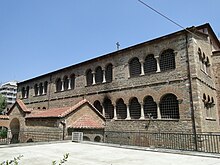Panagia Acheiropoietos
The Panagia Acheiropoietos Church in Thessaloniki ( Greek Παναγία Αχειροποίητος Panagia Achiropiitos ) is a wood-covered, three-aisled basilica from the 5th century. The basilica is one of the few early Byzantine church buildings that have remained almost unchanged in their original form to this day. It is located in the center of the city on Agias Sofias Street opposite Makedonomachon Square just north of Egnatia Street and has been part of the UNESCO World Heritage since 1988 ( early Christian and Byzantine buildings in Thessaloniki ).
history
The church was built on the site of a large thermal complex that was in use until at least the late 4th century. The time when the basilica was built is not historically documented and can essentially only be deduced from references to the monument. As the most important indication of dating to the second half of the 5th century. the building sculpture serves. The church was presumably consecrated to Our Lady from the beginning. The name " Acheiropoietos " ("not made by hands"), which is common today, is derived from an icon of the Mother of God. This designation is first attested by a document from the year 1320. The few older mentions that refer to the church always refer to it as the Church of the Theotokos. Since the 14th century at the latest, the Mother of God was venerated here together with Saint Demetrios . After the Islamic conquest of Thessaloniki in 1430, the Acheiropoietos was the first church in the city to be converted into a mosque . The conversion is documented by an inscription on the eighth column of the north arcade of the nave. From then on, the basilica functioned under the name "Eski Camii" or "Eski cuma camii" (old mosque) as the main mosque of the city. Sultan Mehmet IV prayed here in 1673 when he visited Thessaloniki. After the city passed to Greece, the basilica was temporarily used as an emergency shelter for war refugees; since 1930 it has been used as a church again.
Construction and equipment
The church with its open roof is 36.5 meters long and 28 meters wide. In the west it is closed by a narthex , from which the church is reached via a trivelum. On the south side there is a monumental entrance and the former baptistery . The main nave is closed by a semicircular apse and separated from the side aisles by two-storey arcades . In the east there is a chapel dedicated to St. Irene. The capitals are partly antique, partly from the 5th century, from which mosaics (especially in the arches of the arcades) have been preserved in fragments. 13th century frescoes depict the Forty Martyrs of Sebaste .
Individual evidence
literature
- Ch. Bakirtzis, Sur le donateur et la date des mosaïques d'Acheiropoietos à Thessalonique , Atti del IX congresso internazionale di archeologia christiana, Roma 1975, II Rome 1978, 37-44.
- Ch. Bakirtzis, Ρωμαϊκός Λουτρών και η Αχειροποίητος της Θεσσαλονίκης , in: Αφιέρωμα στη μνήμη, Σταλιανού Πίελεκονατη, Thessaloniki, Αήμκ, 310αμητά Σελεκδαμη32, Thessaloniki 310ΣΣελεκδατ32ατ32.
- B. Fourlas, The mosaics of the Acheiropoietos Basilica in Thessaloniki. A comparative analysis of decorative mosaics of the 5th and 6th centuries , Millennium Studies 35, Berlin 2012.
- WE smallholder, Remarks on the Building History of the Acheiropoietos Church at Thessaloniki in: Πρακτικά του 10ου Διεθνούς Συνεδρίου Χριστιανικής Αρχαιολογίας II, Θεσσαλονίκη 28 Σεπτεμβρίου - 4 Οκτωβρίου 1980 Ελληνικά, Παράρτημα 26 = Studi di Antichità Cristiana 37, Θεσσαλονίκη 1984 241- 257.
- Ch. Kōnstantinidē, Η Αχειροποίητος-Φανερωμένη των πρώτων Παλαιολόγων , Deltion tēs Christianikēs Archaiologikēs Etaireias 24, 2003, 89-100.
- E. Kourkoutidou-Nikolaïdou, Acheiropoietos. The Great Church of the Mother of God , Guides of the Institute of Balkan Studies 11, Thessaloniki 1989.
- Ph. Oraipoulos, Μία άλλη άποψη για τη διαμόρφωση της παλαιοχριστιανικής κόγχης της Αχειροποιήλτου , Η ΘΘσ32 .
- Th. Papazōtos, Ο μεγάλος ναός της Θεοτόκου στη Θεσσαλονίκη. Μια επανεξέταση των πηγών για την ιστορία της Αχειροποιήτου , Μακεδονικά 22, 1982, 112-132.
- K. Th. Raptēs, Παρατηρήσεις επί ορισμένων δομικών στοιχείων της Αχειροποιήτου , To Archaiologiko Ergo ste Makedonia kai Thrakē 13, 1999, 219-237.
Web links
Coordinates: 40 ° 38 ′ 6 " N , 22 ° 56 ′ 53" E


